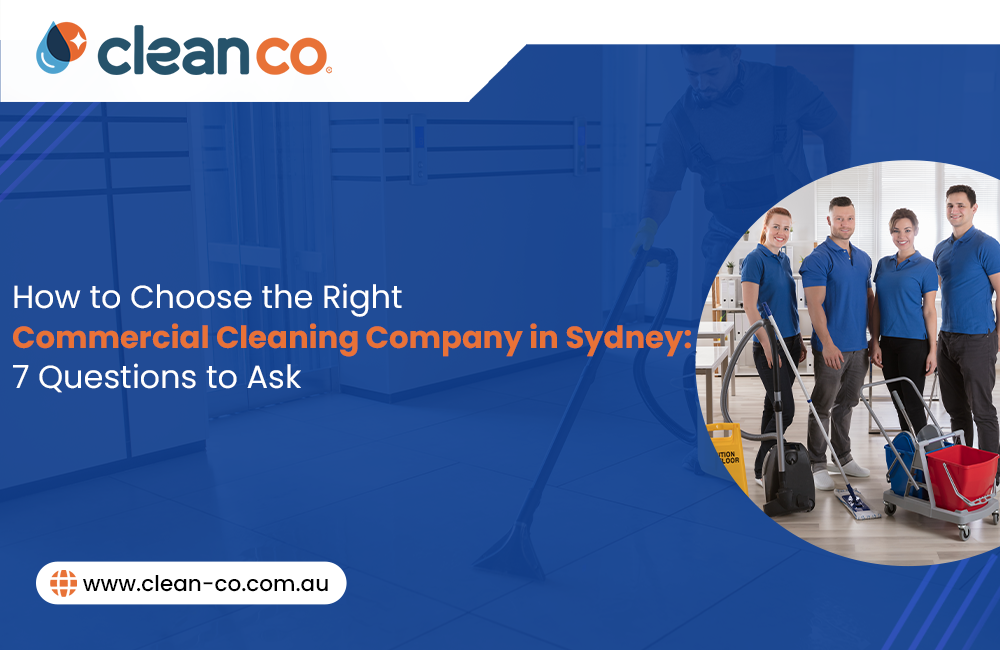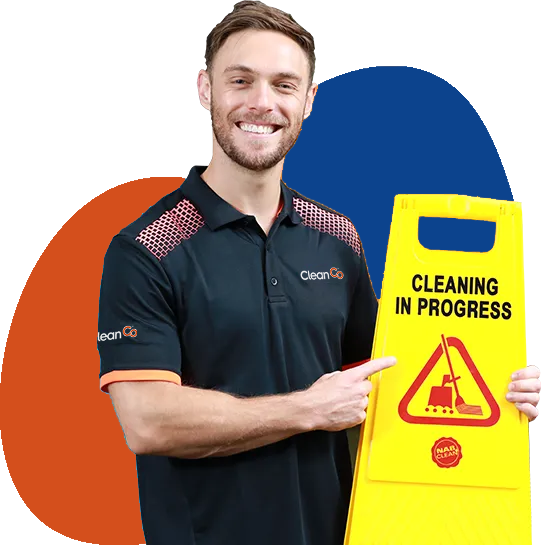Choosing a commercial cleaning partner in Sydney affects safety, uptime, staff morale, and your total cost of ownership. Whether you manage an office, warehouse, school, or strata cleaning services portfolio, the smartest way to avoid scope creep and compliance risk is to demand evidence, not promises. This guide gives you seven proof-driven questions, a side-by-side checklist, and Sydney-specific notes so you can compare vendors fairly and sign with confidence.
Key Takeaways
- Demand compliance proof: WHS policy, SWMS, SDS, insurance—before day one.
- People + process = quality: Police checks, onboarding, supervision, photo-backed audits.
- Scope clarity wins: Area-by-area tasks + calendar-locked periodics (office & strata cleaning services).
- Measure what matters: Monthly QA trend reports with close-out notes.
- No lump-sum traps: Insist on line-item hours, consumables, periodics, SLAs, and guarantees.
1. WHS & Compliance: What documents must a Sydney cleaner provide?
A credible cleaner should proactively provide a compliance pack before onboarding, including the following: current WHS policy, site risk assessment, task-level SWMS, SDS for every chemical on site, and up-to-date Public Liability and Workers’ Compensation certificates. They should demonstrate how inductions are recorded, where SDS are stored on-site, and—for strata cleaning services—show the agreed-upon chemical storage points and common-area access procedures. Practices should align with SafeWork NSW guidance.
Red flags:
- “We’ll share docs after sign-up.”
- Outdated/vague insurance.
- No site-specific induction trial.
- Unlabelled chemicals or missing SDS.
- Generic safety talk with no site controls.
2. Vetting, Training & Supervision: How do they ensure consistent teams?
Reliable outcomes come from vetted people working to clear processes. A solid provider uses verified staff (police checks/ID), formal onboarding, colour-coding hygiene standards to prevent cross-contamination, attendance tracking to ensure coverage, and scheduled supervisor audits with photo evidence and a defined escalation path when standards slip.
Red flags: High staff churn; unverified identities; “shadowing only” training; no supervisor audits or photo logs; a single generic inbox with no named owner.
3. Site-Specific Scope & Periodics Calendar: Will nothing get missed?
Quality hinges on a scope that maps each area to the right method and frequency. Expect an area-by-area plan with daily/weekly/monthly tasks, method notes (e.g., microfibre, HEPA vacuuming), and a calendar-locked program for periodics like carpet extraction, high-dusting, machine scrubbing/sealing, and interior/exterior windows so standards don’t drift.
Red flags: “As needed” language; missing frequencies; periodics not scheduled or excluded from the contract; common-area blind spots (lifts, lobbies, bin rooms, car parks, glass balustrades).
4. Products & Equipment: Are they protecting people and surfaces?
The right chemistry and tools lift hygiene and protect finishes. Look for a documented product list (brand and dilution), preference for low-VOC chemistry, true microfibre systems, HEPA-filtered vacuums, and scrubber-dryers for large floors, with correct labelling and safe on-site storage aligned to GECA/AICIS standards.
Red flags: Strong chemical odours; unlabeled spray bottles; worn pads/cloths; household-grade vacuums; vague answers about brands or dilutions.
5. QA Audits & Reporting: Can you see performance, not guess it?
Professional teams measure what matters. Supervisors conduct planned inspections, score results, attach photos, log close-outs, and share monthly trend reports so you can track hotspots and verify improvements over time; repeated issues trigger coaching or retraining.
Red flags: No inspection schedule; “we don’t get complaints”; no photo evidence or close-out notes; no month-to-month trends; defensive attitude to audits.
6. Communication & SLAs: How fast do they solve problems?
Great cleaning is as much about operations as it is optics. You should have a named account manager, same-day acknowledgement of requests, defined SLA times for spills/biohazards and urgent resets, a simple channel to log jobs (email/portal/WhatsApp with photos), and a clear after-hours plan for access and emergencies.
Red flags: Generic contact only; vague “we’ll do our best”; no after-hours coverage; scattered requests with no central log; no committee-ready summaries for strata sites.
7. Transparent Pricing & Guarantees: Are there surprises later?
Trustworthy proposals make costs and responsibilities explicit: line-item labour hours, task frequencies, consumables (liners, paper, soap), scheduled periodics, add-ons (pressure washing, external windows), fair termination terms, and a performance guarantee tied to QA standards so expectations equal delivery.
Red flags: One-line lump-sum pricing; unclear inclusions; periodics treated as ad-hoc extras; surprise call-out fees; punitive exit terms; routine strata tasks (bin runs, waste-room sanitising, car-park sweeps) only “on request.”
Side-by-Side Vendor Checklist
| Criteria | Why it matters | Ask for | What “great” looks like |
| WHS & SWMS | Safety & liability control | WHS policy + SWMS + SDS + insurance | Compliance pack before start |
| Vetting & Training | Trust & consistency | Police checks + onboarding + refreshers | Police-checked teams; training matrix |
| QA & Audits | Measurable quality | Sample QA report + trend view | Photo-backed monthly QA summary |
| SLAs & Escalation | Fast fixes | SLA times + contact ladder | 2-hour spill response; named PM |
| Scope & Periodics | No missed tasks | Frequency matrix + calendar | Area scope + locked periodics |
| Tools & Chemicals | Hygiene & IAQ | Brand list + SDS + HEPA | Low-VOC + HEPA + microfibre |
| Pricing Clarity | No scope creep | Hours, consumables, add-ons | Line-item costs; fixed periodics |
| Strata Cleaning Services | Common-area standards | Lifts, lobbies, bin rooms, car parks, glass | Strata scope + AGM-ready reporting |
Sydney-Specific Notes
- Coastal offices & strata: Salt air marks glass faster—tighten interior window cycles; consider hydrophobic coatings on balustrades and lobby glass.
- CBD towers (Barangaroo/Martin Place): After-hours access and lift bookings need tighter planning; agree on an event reset plan.
- Industrial (Wetherill Park): Scrubber-dryer programs, walk-off mat maintenance, and quarterly high-dusting reduce particulate transfer.
Results seen: A CBD office cut presentation complaints by 62% in 60 days; an industrial site reduced dust incidents by 48% with scheduled scrubber-dryer passes and mat maintenance.
Conclusion
Selecting a Sydney cleaning company is a risk decision, as is a price decision. When you demand compliance proof, insist on a site-specific scope with a locked periodics calendar, and monitor QA trend reports against clear SLAs, you protect people, assets, and brand—across offices, warehouses, schools, and strata cleaning services. Use the seven questions and the checklist above to compare finalists on proof, not promises, and choose a partner that keeps your workplace and common areas consistently clean, safe, and hassle-free.
Next step: Book a 15-minute walkthrough and request the WHS/SWMS/SDS pack, area-based scope, frequency matrix, periodic calendar, and a sample QA report.
FAQ
- Biggest red flag when vetting a cleaner?
A lump-sum quote with vague inclusions or “we’ll share WHS documents after sign-up.” - How much does commercial cleaning cost per m² in Sydney?
It varies by site type, traffic, hours, and periodics; compare line-item hours plus a periodics calendar to judge value. - Standard vs deep clean what’s included?
Standard: bins, desks, kitchens, bathrooms, floors, touchpoints. Deep: carpet extraction, high-dusting, vent/detail cleans, machine scrubbing, sealing. - What should strata cleaning services include?
Lifts, lobbies, bin rooms, car parks, glass/balustrades, gardens/paths interface, plus a periodic calendar and AGM-ready reports for committees.


